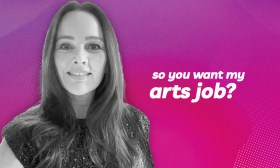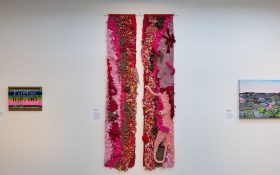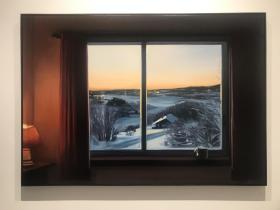Congratulations, because there are two things very much strongly in your favour. Firstly, this is the age of the internet with the wafer-thing possibility of unprecedentedly huge audiences; and secondly, this is Aotearoa, and everyone knows everyone else.
Being a big fish in a small pond is an excellent basis for becoming a respectably sized fish in a big pond, but baby steps first.
Not gonna lie, still a slog.
Now, be aware it can be brutal out there, once you’re figured out what ‘there’ you want to put yourself ‘out there’ in.
A hide like a rhino helps.
I long ago took the mantra that ‘art is far too important to take too seriously’ – this seems to help me get up again after I’ve fallen down for the umpteenth time.
Consider the following snippet of dialogue from the movie Labyrinth when Jareth the Goblin King (David Bowie in tight trousers and Tina Turner wig) tells Sarah (Jennifer Connelly full of pre-The Hot Spot innocence) when she once more complains that his games are not fair: ‘You say that so often, I wonder what your basis for comparison is?’
The most important things are:
- Commit to it and learn from every setback
- There will be setbacks. Everyone, their mother, and their dog are going to tell you no
- Sometimes they will be right to say no, and you should find out why they said no and learn from it
- But setbacks aren’t the end – they’re just an opportunity to pivot
- Some people are just shits and there’s not much you can do about that
- And in the words of those great British philosophers S Club 7, ‘Don’t stop, never give up / Hold your head high and reach the top / Let the world see what you have got…’
At this point, someone inevitably complains that this is all very glib, the world is prejudiced against them and I’m blind to my privilege. Sadly, while much of this is true, internalising that kind of pessimism can easily become a form of self-sabotage.
Real talk: I can’t guarantee you success, but I can guarantee that you won’t succeed if you don’t realise that there are lots of people from various marginalised groups who have broken through those barriers and will continue to do so because they know what they want, putting a few more cobbles in the road.
Especially now, when contrary to the popular mantra, the creative industry (and it is an industry, not a lifestyle) is bending over backward to cynically exploit minority talent.
It’s not the politically correct thing to say – but it’s true – and if you are able to lean into identity politics for access, it is a fully legitimate strategy. Be cynical as well and exploit it back.
Take every edge you can – ‘culture’ is a bigoted system of privilege so you might as well, and things will only change with visibility. Again, of course, this may not be the path you choose, and that is perfectly legitimate and fine as well.
In general, no one is going to promote yourself as well as you can, so self-promote.
Instagram is amazing for writers and artists alike because your audience can find you. They might not be a terribly discerning audience (Rupi Kaur fans, I’m looking at you), but that’s beside the point.
For writers, some of the advice hasn’t changed in over a century.
Submit, collect the rejections, and revise. You will be rejected.
A lot.
Like a helluva lot.
But statistically, eventually someone has to take a punt on you.
Rejection doesn’t mean that you’re necessarily bad at what you do, it just means the competition is incredibly stiff. Nobody owes you anything. Give them a reason, a particularly interesting voice or perspective.
Keep submitting.
It’s also quite common to hear people complain about being ‘paid in exposure’. Of course, people should be paid for their labour, but it is equally true that you should be paid what you’re worth and no one is going to know your worth if they can’t see your work.
At this stage, you won’t be trying to live off your creativity full time – so you have some room to do a couple of free jobs for the exposure. It’s not forever, but you won’t get anywhere if you don’t get your foot in the door.
Keep submitting.
BE VISIBLE
For the emerging visual artist, it’s just as much about being seen but often with a far stronger social element.
These days, there is also a profound drift away from the traditional dealer system – as artists want to keep more of their cut, dealers are cutting their margins and expanding their cut to afford the rising costs of gallery space.
Don’t get me wrong though – a good dealer has a stable of dedicated collectors and they work hard to promote their artists. They are still a vital part of the ecosystem, but they no longer are the only way to find an audience.
If you went to art school, you will hopefully have made a bunch of artist friends at a similar point in their careers. Get together and organise pop-up group shows.
Have you seen the state of High Streets in Aotearoa? So many empty shops, killed by suburban shopping malls. Commercial landlords realise that getting foot traffic around those empty retail spaces is good for them and are often quite open to a cheap or free lease for a short-term event.
Have a group show. Organisations like Christchurch’s Life in Vacant Spaces and Wellington’s Urban Dream Brokerage are great places to start.

Artists tend to be entrepreneurial by nature. In the words of Tim Gunn, ‘make it work’.
Become a part of the scene. Yes, I know how cliché that sounds, but it’s true.
Get on those gallery mailing lists, show up to the openings (not just for the free wine), make friends with the dealers, collectors, and other artists. It’s probably not what you want to hear if you’re an introvert, but it’s not rocket surgery.
Dress tidily and be polite. I shouldn’t have to say that, but you’d be surprised.
Also always eat something before an opening. Getting known for getting drunk at openings will quickly make you persona non grata unless you’re that rarest of unicorns, the sparkling lush.
Have a good website that’s clear, legible, and not gimmicky or annoying. People don’t want to have to hunt for the menu or struggle with a quirky font. It might be smart to get someone who knows what they’re doing to set it up for you.
Don’t focus on getting representation straightaway. It’s not automatic or immediate. It’s much more important to build your CV and short circuit the Catch-22 bootstraps absurdity of it all.
It doesn’t overly matter where those shows are – pop-ups, student shows, artist-run spaces, community art projects, public libraries, interventions in public space, poetry readings.
Hell, friends of mine once staged a whole series of exhibitions of their other friends’ work in their flat’s garage after the Christchurch quakes.
Cafés are also underrated as venues for culture. Or get even more creative like the greatly missed Physics Room kiosk in Christchurch or The Parasite at the Royal College of Art in London. The Absinthe project ran a series of shows in a London pub called The Spit and Sawdust.
STYLING AND PROFILING

It is hugely important – and I cannot overstate this – for anyone in the creative industry to work on their profile, networks, and relationships. You, as an individual, are part of a whole interdependent ecosystem.
That means researching the magazine you’re submitting to (I’ll talk about how to write a submission cover letter another time). If you want to be in an exhibition, research curators, galleries, media, and other artists.
If you can tame someone in the art media and make them an ally, this is one of your best assets.
Seize every opportunity to get your work out there. Hustle. Be professional and polite. Be memorable. Be engaging and present. Take the initiative but by the same token, some people are scumbags and don’t be afraid to leave situations that make you uncomfortable.
If you have something published, exhibited, or performed, market the bejeezus out of it.
Put it on all of your social media two or three times a day. Tell everyone. Print posters and flyers (these days that is probably going to make you stand out against the tsunami of electronic spam).
This enthusiasm will also entice other people to want to work with you and attract more opportunities.
Be an active participant. If you’re part of a group show, offer to invigilate (I love that word, so fancy and grown-up, but all it means is mind the shop).
Empower yourself and create opportunities for yourself and others. Curate your own group shows, start your own literary magazine, create your own residencies even if it’s just your spare room.
Look at Christchurch’s SCAPE public art festival. That only exists because twenty years ago Deborah McCormick, fresh out of art school, understood the importance of networking. She wasn’t one of the city’s First Four Ships brahmin, but through perseverance, communication, and networking she managed to get a group of institutions and local businesses together to provide resources and a modest budget of around a million dollars for the first SCAPE and it’s still going.

McCormick has this to say about those beginnings:
‘The idea for SCAPE started with a call for expressions of interest by the organisation Artworks, set up by Warren Pringle in 1997. Artworks was established in response to a lack of professional infrastructure to tour contemporary art projects and develop local opportunities for artists in Christchurch.
‘Pringle was familiar with a similar project, Edge, in London, and as an experienced art administrator, approached Christchurch MP Tim Barnett for support. Warren was well connected with Council and arts advocates in the media and academia.
‘I was just out of art school and had this idea for a high-profile arts event and to encourage professional development and raise the profile of New Zealand artists, while raising the public profile of local business and industries for their support of the arts. I saw that Warren, Artworks and I were philosophically aligned.
‘SCAPE’s success owed a lot to bringing the right people onto the establishment board, a young and enthusiastic graduate arts student (me) trying to find a job at the end of an expensive degree, support of commercial and industrial business working with artists making work and gifting materials and identifying Warren as someone with the interest and experience to help mould those ideas and with me making the connections to realise them.”

Never be too proud to learn from people who have cracked the codes. That’s one area in which volunteering can be useful.
If people show an interest in your work, try to get their contact details for a newsletter and encourage them to follow your social media.
The movers and shakers of the creative world want to see that you have drive and that your work is evolving. This is also very useful in giving plenty of notice for your events. No one likes last-minute invitations when they already have plans.
Design and print a striking business card and carry them around with you. Give them out at events. Collect other people’s business cards. When you meet someone useful, follow it up with an email telling them how nice it was to meet them. Be proactive and pleasant.
For visual artists, the written word isn’t always what they’re good at, so when you put together that all-important biographical paragraph or artist statement, take your time and don’t be afraid to seek help from a friendly writer.
A PRESSING TOPIC
Everyone should know how to write a press release.
For the purposes of the creative world, you need to remember that journalists aren’t critics, aren’t specialists, and their editor is less concerned with getting the dates and times right than having the copy yesterday.
Spend a few days making your own media list. The easiest way to do this is a spreadsheet with
- the name of the publication
- contact details
- name of the journalist or editor most relevant to the context
- notes about angles they are likely to be interested in.
Create separate sections for general and specialist media and tailor your release accordingly. Update regularly.
Try to put yourself in the headspace of a harried, overworked journalist who doesn’t care much about art. Why should they care about this exhibition? What is the who, what, where, and why? What makes it newsworthy?
Eschew theory and jargon. No one cares. Explain things as simply and clearly as possible. In bullet points. No more than a couple of sentences a paragraph. No more than three lines to a sentence. Include the date you circulated the release in the header.
Make sure the essential information, particularly dates, times, and names, is obvious. Include a couple of personable, relatable quotes that they can slot into the copy to engage their readers.
If you want it to come out at a precise time, put ‘ATTENTION: EMBARGOED UNTIL… xyz’ at the top.
You can get a little bit more detailed with specialist arts media. I suggest you invite art writers to engage with you directly. Same with critics, but they’ll likely come to their own conclusions anyway.
Remember to include your contact details. Always have the best high-resolution images you can available – 1200px on the longest side, in RGB format for maximum compatibility, but check what the recipient’s preferred format is as this can vary.
Check what the recipient’s preferred method of file share is (usually either DropBox or WeTransfer is best, though some organisations can be security cautious about these so don’t assume).
Be available for follow-ups – but try to get it right the first time because no one likes having to chase stuff up.
Really important: be aware of lead times. Is a publication daily, weekly, monthly, quarterly? If something only comes out three or four times a year they need plenty of advance warning.
Don’t be too upset if, after all this, coverage doesn’t eventuate. The arts are a low priority for most general publications.
IT’S NOT WORKING
While it is true that the interconnected internet age makes it easier than ever to find an audience and for an audience to find you, it by no means guarantees it.
If you have been following the above advice and hustling for a while, yet are still struggling to find an audience, you may have to sit down and ask yourself some hard questions about your work.
What is the value for others in your work?
By that I don’t mean as an investment or what the materials are worth, but the style, the content, the expression. If you are a writer, what are you contributing? Do you have an interesting or engaging point of view, an expert message to convey, an earnest heart full of emotion, or an intriguing prose style?
Similar questions apply to other art forms, and this is probably the most difficult thing to get right because without it, you might as well find another career.
For example, does your work have a recognisable voice that identifies it as yours? Is it consistent? Does it show depth and growth? Is it technically proficient? Does it have an originality to it?
Even if that originality comes from being able to synthesise something new from existing source material (think Pop Art and Hip Hop) and resolving it with a personal spin, it’s the individuality that attracts attention.
The five key things here are empathy for human experience, experimentation, practice, retaining a curiosity about the world, and being open to new ideas and influences.
If you are prepared to be honest in your self-critique and open to objective feedback from people who know what they’re talking about, this is relatively easy to sort out.
Maybe it’s sloppy technique that’s putting people off.
Maybe it’s the way you’re communicating your message – for instance, politically aware rage has its place but can be alienating where a more reparative and aesthetically-driven approach will have more success.
Is your work as articulate and resolved as it could be?
However, while feedback is useful, sometimes it isn’t particularly helpful, and you aren’t under any onus to always heed it. That said, get used to being ruthless with your work – ‘kill your darlings’ – learn to judge when something is finished, and know when to stop flogging a dead horse.
It’s very unlikely people are just going to stumble over your movie review blog or the painting at your grandmother’s house.
You need to put your work where the people are.
That takes research, networking, getting to know your audience and learning to understand the context in which your work is experienced.
Market yourself and your work – remember that the world is saturated with disposable words and imagery and we’re all competing for that precious, ever-diminishing attention span.
Find that niche.
Until next time my lovelies,
Ngā mihi nui
APW XOXO

Written by Andrew Paul Wood. This story was originally published by The Big Idea.





